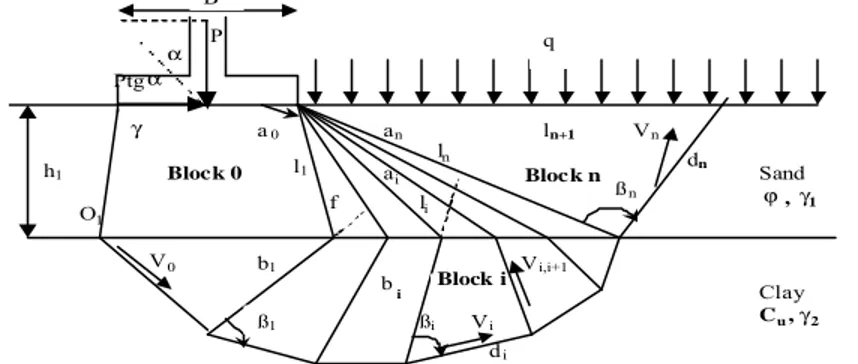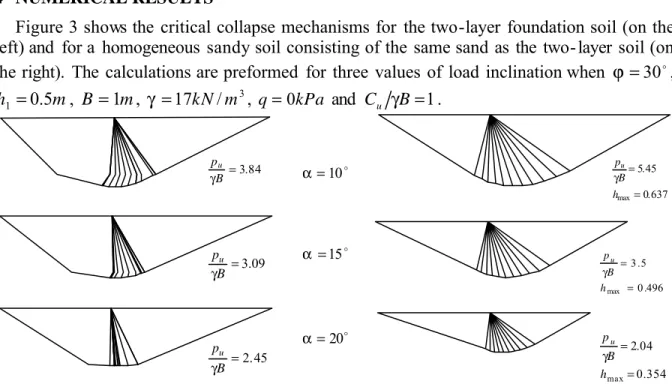HAL Id: hal-01007934
https://hal.archives-ouvertes.fr/hal-01007934
Submitted on 21 Oct 2018HAL is a multi-disciplinary open access archive for the deposit and dissemination of sci-entific research documents, whether they are
pub-L’archive ouverte pluridisciplinaire HAL, est destinée au dépôt et à la diffusion de documents scientifiques de niveau recherche, publiés ou non,
Bearing capacity of eccentrically and/or obliquely
loaded strip footings over two-layer foundation soils by a
kinematical approach
Dalia Youssef Abdel Massih, Elias El-Hachem, Abdul-Hamid Soubra
To cite this version:
Dalia Youssef Abdel Massih, Elias El-Hachem, Abdul-Hamid Soubra. Bearing capacity of eccentrically and/or obliquely loaded strip footings over two-layer foundation soils by a kinematical approach. VIII International Conference on Computational Plasticity - Fundamentals and Applications (COMPLAS 2005), 2005, Barcelone, France. �hal-01007934�
BEARING CAPACITY OF ECCENTRICALLY AND/OR OBLIQUELY
LOADED STRIP FOOTING OVER TWO-LAYER FOUNDATION SOIL
BY A KINEMATICAL APPROACH
Dalia Youssef Abdel Massih*†, Elias El-Hachem† and Abdul-Hamid Soubra*
* University of Nantes
GéM - Bd. de l’Université - BP 152 - F44603 Saint-Nazaire Cedex - France
E-mails: {Abed.Soubra ; Dalia.Youssef} @univ-nantes.fr, web page: http://www.univ-nantes.fr
† Lebanese University
Faculty of engineering II - Roumieh - Lebanon E-mail: EliasHachem@ul.edu.lb, web page: http://ul.edu.lb
Key words: footing, bearing capacity, limit analysis, layered soil.
Summary. The aim of this paper is to determine the bearing capacity of a strip footing
resting on a two-layer foundation soil sand/clay by a kinematical approach in limit analysis. Inclined and eccentric loading are considered in the analysis using translational and rotational failure mechanisms. Numerical results are presented and discussed.
1 INTRODUCTION
The bearing capacity of foundations on soft clay can be improved by placing a layer of compacted sand or gravel. To determine the ultimate bearing capacity of a two-layer foundation soil (sand over clay) subjected to a vertical load, the most widely used approaches in practice are the traditional semi-empirical solutions of Meyerhoff and the load spread model. Recently, a rigorous approach based on the upper-bound technique of limit analysis has been used by Michalowski and Shi (1995) [1]. Also, numerical simulations have been performed by Frydman and Burd (1997) [2].
The aim of this paper is to determine the ultimate bearing capacity of a strip footing resting on a two-layer foundation soil (sand/clay) in the case of inclined and/or eccentric load. The method used is the upper-bound approach of the limit analysis theory.
2 COLLAPSE MECHANISMS
Two failure mechanisms M1 and M2 are presented in this section for the computation of the bearing capacity of a strip footing on a two-layer foundation soil.
2.1 Mechanism M1: Case of an inclined load
M1 is a translational failure mechanism (Figure 1). It allows the calculation of the ultimate bearing capacity of a strip footing subjected to an inclined load. This mechanism is similar in shape to the multiblock non–symmetrical mechanism considered by Soubra (1999) [3] in the
case of a homogeneous soil. In the present mechanism however, each radial surface separating two adjacent rigid blocks consists of two lines inclined at an angle f to each others in order to respect the normality condition. This mechanism is an extension of the symmetrical mechanism presented by Michalowski and Shi (1995) [1] in the case of a vertical load.
Figure 1: Collapse mechanism for inclined load 2.2 Mechanism M2: Case of an eccentric load
M2 is a rotational mechanism (Figure 2). It is used for the computation of the ultimate bearing capacity of a strip footing subjected to an eccentric load with or without load inclination. This mechanism is a generalization of the traditional log-spiral mechanism considered in the stability analysis of a homogeneous soil mass. In the present mechanism however, the log-spiral reduces to a circle when its passes through the clay layer.
Figure 2 : Collapse mechanism for eccentric load 3 WORK EQUATION
It follows from the incompressibility of clay that the net work done by the weight of the clay must be zero. So, the solution of the bearing capacity must be independent of the specific weight of the clay. This hypothesis was adopted by Michalowski and Shi (1995) [1].
By equating the rate of energy dissipation to the rate of work done by the external forces for the two mechanisms presented above, one obtains:
di α P Ptgα γ O1 h1 Block n ln+1 a0 l1 dn li Block i Block 0 b1 bi ßn an ai ßi f B ß1 Clay Cu , γ2 Sand ϕ , γ1 ln q Vi Vi,i+1 V0 Vn B α cos P Sand 1 ,γ ϕ Clay 2 ,γ u C 0 θ h θ ' 0 θ θh' α q 1 h e O
C u q u N B C N B q N B p . . . . . 2 1 . γ γ γ = γ + + (1)
in which B is the footing breadth, γ is the unit weight of the sand, Cu is the undrained shear
strength of the clay, q is the surcharge loading and pu is the ultimate bearing pressure. The
minimization of this function with respect to the geometrical parameters of the failure mechanisms gives the limit bearing capacity and the corresponding critical failure surface.
4 NUMERICAL RESULTS
Figure 3 shows the critical collapse mechanisms for the two-layer foundation soil (on the left) and for a homogeneous sandy soil consisting of the same sand as the two-layer soil (on the right). The calculations are preformed for three values of load inclination when ϕ =30o,
m
h1 =0.5 , B =1m, γ =17kN/m3, q=0kPa and Cu γB=1.
Figure 3: Collapse Mechanisms for the two-layer punching mechanism (left) and for the homogeneous sandy soil mechanism (right) for three values of load inclination
For the two-layer punching mechanism, the bearing capacity decreases with the load inclination increase (cf. Figure 3 left). Also, it can be seen that the depth of the failure mechanism decreases with the load inclination. The collapse mechanism is entirely contained in the sand layer for high inclination. In that case, a sliding along the clay-sand interface is observed. For the homogeneous granular soil, the critical failure mechanism becomes shallower with an increase in load inclination (cf. Figure 3 right). The minimal bearing capacity value obtained from both failure mechanisms is conserved even for a depth of the granular soil mechanism smaller than that of the sand layer.
A critical depth for the sand layer is defined in this paper. It is the largest depth of the sand that still has an effect on the limit pressure. The weaker the clay layer, the larger the depth up to which the clay has an adverse effect on the bearing capacity. Also, the stronger sand is, the larger the critical depth.
84 . 3 = B pu γ 45 . 2 = B pu γ 496 . 0 5 . 3 max = = h B pu γ 354 . 0 04 . 2 max= = h B pu γ 09 . 3 = B pu γ o 20 = α o 15 = α o 10 = α 637 .0 45 .5 max= = h B pu γ
Two design charts for ultimate pressure pu
( )
γ.B are given in Figure 4 as function of( )
BCu γ. and h1 B for given values of α and e B when φ =30° and q=0. The critical
depth is accounted for in the charts. As expected, the limit pressure increases with an increase in the depth of the sand layer. It also increases with the clay strength. For most cases, the limit pressure reaches a constant value and further increase in the clay strength does not improve the bearing capacity. This limit is equal to the bearing capacity of the granular soil. Only when the clay is strong and the layer of sand overlying the clay is thin relative to the footing breadth can the bearing capacity increase beyond that expected for a homogeneous granular soil. φ = 30o α = 5o 0 5 10 15 20 0 1 2 3 4 5 Cu/(γ .B) pu /(γ.B) φ = 30o e/B = 1/8 0 5 10 15 20 25 0 1 2 3 4 5 Cu/(γ .B) pu /(γ.B)
Figure 4: Design charts for bearing pressure (q=0). 5 CONCLUSION
The upper-bound method of limit analysis is used to determine the ultimate bearing capacity of a strip footing resting on a two-layer foundation soil in the case of an inclined or eccentric load. A critical depth of the sand layer is defined. This is the largest depth of the sand layer that still has an effect on the limit pressure. Numerical results have shown that the limit pressure increases with an increase in the strength of the clay. For most cases, it reaches the bearing capacity of the homogeneous granular soil. Only when the clay is strong and the layer of sand is thin relative to the footing breadth can the bearing capacity increase beyond that expected for a homogeneous granular soil. Numerical simulations and centrifuge experimental results are needed to validate the present upper-bound solutions.
6 REFERENCES
[1] Michalowski, R.L., and Shi, L. (1995) “Bearing capacity of footings over two-layer foundation soils”, J.
Geotech. Engrg., ASCE, vol. 121, No.5, p. 421-428.
[2] Frydman, S., and Burd, H.J., (1997) “Bearing capacity of plane strain footings on layered soils ”, Can.
Geotech. J., vol. 34, p. 241-253.
[3] Soubra, A.-H. (1999) “Upper-bound solutions for bearing capacity of foundations”, J. Geotech. and
Geoenvir. Engrg., ASCE, vol. 125, No.1, p. 59-68.
h1/B = 0.5 1 1.5 h1/B = 0.5 1 1.5 2


